The new Essential Eight technologies: what you need to know
If you’re a business leader, your company is almost certainly using at least several of the Essential Eight emerging technologies right now. You’ll likely need to use others soon. Since these technologies can be so transformative, understanding what they can do will be fundamental for both everyday operations and long-term strategy.
In 2016, we first identified the Essential Eight — settling on the crucial shortlist after analyzing more than 250 technologies in our labs. Since then, much has changed. Several of the Essential Eight have advanced so quickly that the value propositions they offer business have changed. Still other, newer technologies are now becoming instrumental. To help businesses assess where to direct strategic investments, we’ve updated the Essential Eight and organized them into three categories that reflect how business leaders can prioritize their efforts: expand, evaluate and experiment.
Essential to expand
These technologies are used at scale in many enterprises, and many companies are ready to expand further. If you’re not looking at more widespread implementation, you should be.
Though the technologies are at different maturity levels, we believe all eight are essential. They’re also converging to deliver greater impact. While a single Essential Eight technology may help solve a business challenge, combining it with others may enhance the solution. And when used together, multiple emerging technologies can help derive new value from the data that each one is collecting or creating.
Another common trait that unites the Essential Eight is the necessity of trust. Leadership and external stakeholders need to trust that the technology can deliver the value it promises, have its risks addressed, fulfill compliance requirements and align with corporate values. And employees need to have trust that this technology will not replace them, but instead make them more valuable.
The right approach to the Essential Eight can help build trust with your stakeholders, prioritize key investments and drive convergence among these technologies that can lead to exponential value.


Essential to expand
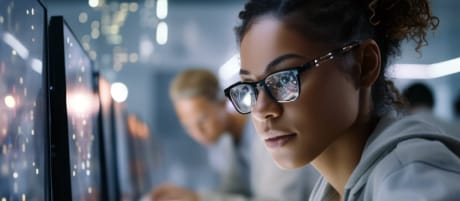
Artificial intelligence
AI reached a tipping point in 2023. One type, generative AI (GenAI), is so powerful and easy to use, it’s starting to change business models and revolutionize how work gets done. Conventional AI is advancing too, delivering greater productivity and new revenue streams. This includes the foundational subfields such as machine learning, deep learning, and knowledge representation and reasoning — techniques that seek to imitate how humans learn, process knowledge and make educated decisions.
AI today is no longer the exclusive domain of data scientists and software engineers. Traditional knowledge workers everywhere are using it — anyone can create content using simple human text-based prompts. AI’s potential to deliver value keeps growing, both as a stand-alone technology and as an enabler of other technologies, and many types of AI are already being used responsibly and at scale across organizations to help solve everyday challenges.
The bottom line: AI is already growing productivity and driving efficiency. With GenAI leading the way, AI is poised to scale quickly, enable new business models and transform how work gets done.
The technology in action
- Productivity improvements: Companies are using AI across functions (such as tax and legal) and lines of business. GenAI for customer service, for example, can answer routine questions, route hard questions to the right specialists and give them information to provide better answers.
- Data and decisions: AI and GenAI can help gather, summarize, analyze, safeguard and disseminate data — enabling faster analysis and more data-driven decisions.
- Stakeholder trust: AI can automate or augment predictive maintenance, fraud detection, cybersecurity, supply chain oversight and more. GenAI can boost transparency by helping to summarize, verify and generate data and reports.
What’s next
AI may change nearly everything about knowledge work, thanks in part to the emergence of GenAI — but it won’t replace people. When implemented as part of a human-led, tech-powered approach, AI can make both people and the organizations where they work more valuable. Both AI and GenAI can detect anomalies in data to help humans make better decisions, and organizations that capitalize on both are likely to see an increase in productivity.
New productivity from AI can help enable new business models (such as ones based on hyper-customization) that had previously been too costly. AI may also help companies perform more advanced R&D. GenAI can help companies complete work (such as software development) in-house that is often partly outsourced.

Where to start
- Deploy AI responsibly. Our Responsible AI toolkit offers frameworks, templates and code-based assets for your AI strategy. It’s a powerful foundation to instill trust in both conventional and generative AI. It considers factors that include data governance, security, compliance, ethics, and robust model development.
- Start fast. Take advantage of how a single, repeatable “pattern” of generative AI training and deployment can apply across your value chain. AI can offer greater ROI when you deploy an AI factory to achieve scale quickly.
- Ready your workforce. Consider explicit usage policies and upskill your employees while encouraging a culture of experimentation, iteration and persistence.
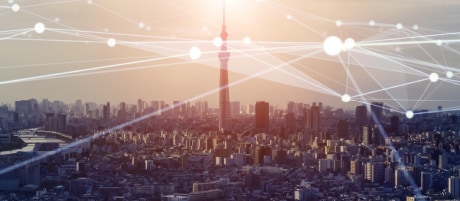

Internet of things
The Internet of Things (IoT) might as well be called the internet of (almost) everything. From wearables and home appliances to enterprise-level devices, IoT makes systems more intelligent and enhances decision-making. Some might say that IoT is becoming as integral to business today as electricity. IoT applications can be pivotal for innovation, enhancing operational efficiencies, improving compliance and creating sustainable, competitive advantages.
The bottom line: Today’s IoT is about recognizing how the technology can enable data-driven insights and support a wide range of use cases — helping drive efficiency as well as business transformation.
The technology in action
- Predictive maintenance, smart energy and remote monitoring: IoT can be used to help anticipate equipment failures, reduce downtime and extend the life of machinery. It can also be used for smart energy management, helping to improve consumption and lower operational costs. Remote monitoring helps provide system integrity and swift response to anomalies, while also personalizing customer experiences.
- Asset management: IoT has transformative potential in asset management — enabling real-time tracking and enhancing resource usage — and in refining supply chain efficiency and transparency. With such deep visibility, IoT has the potential to help enable improved insurability of assets.
- ESG enablement: Data from environmental sensors and other IoT devices can be used to establish a governance, risk and controls framework that can help support the completeness and accuracy of data for investor-grade reporting. Moreover, with additional feedback and control mechanisms, IoT can be used to manage asset power levels to dynamically enable energy management.
What’s next
Rising miniaturization and cost-effectiveness of computer hardware, as well as sensors and lower communication costs, are transforming IoT. The availability of shared radio spectrum is fostering more pervasive private networks, potentially enhancing the IoT’s expanded use in many settings. With 5G cellular technology, reliability and data integrity is only getting better. This rapid expansion may also increase concerns around trust and privacy. Robust regulatory frameworks and strong internal governance can help safeguard user interests and enable responsible technological advancement.

Where to start
- Prepare to scale. Even if you choose to deploy IoT for limited tasks only, building a technology and process foundation (including privacy and data governance) can help you roll it out at scale later.
- Oversee to improve. IoT data can help you monitor, assess and enhance operations. It can, for example, pinpoint unused space in facilities or unnecessarily repetitive processes.
- Uplift your strategy. As IoT data offers new ways to increase productivity and tap into customer preferences, you may find ways to enhance strategy in areas like new customer experiences, supply chains or even business models.


Essential to evaluate
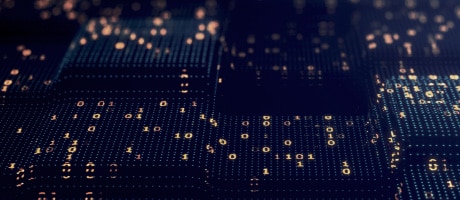

Blockchain
Blockchain can provide transparent, cost-effective and secure ways to store, monitor and transfer information and assets — helping enable new digital business models and revenue opportunities. Growing adoption, interoperability advancements and regulatory clarity are positioning blockchain to become a critical enabler of enterprise innovation and trust.
Blockchain is designed to seamlessly integrate with existing company systems, processes and data sources while also enabling trusted interactions between external ecosystem participants. Its decentralized nature can provide businesses with greater agility, flexibility and new, trusted ways to interact with customers, counterparties and other stakeholders. Better yet, the ecosystem effect enables companies to offer integrated solutions or services that combine the strengths of multiple participants to help attract new customers.
The bottom line: Blockchain is poised to be a building block of the global economy, enhancing trust and securing financial transactions, safeguarding data, verifying digital identities and streamlining essential business processes.
The technology in action
- Global payments: Blockchain’s identity and value portability features may be a game changer for cross-industry financial processes and transactions such as customer and commercial payments, global payroll and treasury management.
- Asset tokenization: Blockchain can facilitate the minting and exchange of digital representations of tangible assets, including investment funds and real estate, to more seamlessly create, transfer and track assets throughout their life cycle.
- ESG enablement: Blockchain can improve environmental monitoring and reporting, and it may offer a more sustainable alternative to legacy data and information systems to help support an organization’s decarbonization efforts. Further, it can help provide greater access to quality and trustworthy financial services — payments, savings accounts and investments, for instance — to support greater usage in financially-underserved communities.
- Technology and data governance: Blockchain’s fundamental feature of immutable records can help govern and instill stakeholder trust in other emerging technologies that are being increasingly adopted by businesses.
What’s next
As the digital economy grows, blockchain’s importance will likely grow too. Regulatory clarity surrounding blockchain deployment has helped instill confidence in businesses and institutions that are exploring and adopting blockchain solutions. It is also encouraging other companies to follow suit. These companies will likely focus on invisible blockchain — applications that drive process efficiencies or enable new internal or customer-facing capabilities without drawing attention to blockchain as the backend. New entrants can emphasize the need for collaboration across ecosystem participants to enable appropriate guardrails are in place to maintain trust.

Where to start
- Prepare for decentralized interaction across your value chain. Blockchain is designed to be an ecosystem technology, facilitating greater collaboration between businesses and transparency to stakeholders. Consider your business objectives to determine the role your company should play in the ecosystem.
- Understand your use case, innovate with a fit-for-purpose solution and understand the regulatory impact across your business. Evaluate the compliance requirements, data privacy regulations and potential legal challenges associated with blockchain adoption and scaling.
- Assess potential collaborative opportunities. Determine whether your company can benefit from utilizing existing blockchain networks, or industry-specific alliances. Be prepared to collaborate with ecosystem participants on key decisions, such as consensus mechanism, governance structure, data privacy and security standards, and how commercial benefits can be shared.
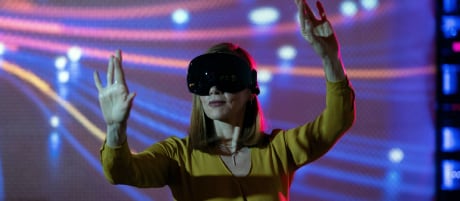

Virtual reality
Virtual reality (VR) can transport you, your employees and your customers into a designed, digital environment that feels increasingly real. Both the metaverse and virtual environments inside individual organizations are hosting more and more business applications. For example, VR environments can already enable agile teams around the world to collaborate on daily sprints. Through VR, these teams can access data, tools and their teammates’ insights. VR’s rising ease of use and realism — helped by the integration of AI and of eye and facial tracking — is poised to blur the line between digital and physical worlds. That could transform customer and employee experiences, stakeholder trust and more.
The bottom line: VR is already a powerful tool for upskilling and workforce collaboration. In the near future, its startling realism could transform employee and customer experiences and companies’ daily operations.
The technology in action
- Upskilling: Research has shown that VR is both powerful and cost-effective in teaching soft skills such as leadership and resilience. Employees can also practice complex or dangerous physical tasks in safe, realistic environments.
- “Better-than-real-life” work environments: VR’s rising realism and the comfort offered by new headsets is enabling more productive collaborations among employees as well as interactive access to 3D models of things like product designs and marketing campaigns.
- Collaboration: Photorealistic avatars are poised to enable you and your stakeholders to “feel” each other’s presence — offering engagement and trust-building opportunities remotely.
- Customer engagement: Realistic, immersive spaces can offer powerful new channels for sales and community-building around brands.
What’s next
VR is poised to enter more everyday business operations. 3D mapping and real-time tracking cameras could soon enable life-like photorealistic representations of people — transforming activities like workplace collaboration, employee recruitment, customer engagement and investor relations. Realistic, easy-to-use virtual workplaces could help offer employees more flexibility while increasing productivity and reducing carbon emissions.
Integrated into VR, GenAI is allowing even non-specialists to create intricate virtual environments, lifelike “metahumans” and 3D models. Together, GenAI and advances in low-cost hardware are helping autonomous virtual agents perform business relevant tasks (such as customer service) in VR environments.

Where to start
- Start with tested use cases. VR applications for upskilling, remote collaboration and visualizing of complex design environments have already demonstrated their potency and their potential for rapid ROI. Such internal use cases can also increase institutional familiarity with the technology in lower-risk scenarios.
- Enable innovation and creativity. Virtual environments can make it easier for employees to propose and experiment with ideas without incurring significant costs or risks — so long as your culture encourages them to speak up and innovate.
- Create opportunities to help the business. Connect business and tech teams in VR initiatives or hackathons focused on business problems. Together, these teams may find new ways to build solutions that even those without a VR background can use, improve and scale.
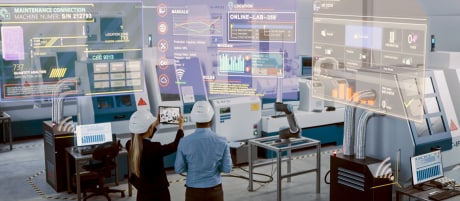

Augmented reality
Augmented reality (AR) overlays digital elements onto the real world, enabling new experiences and ways to access data. Advances in computer vision, object recognition and IoT capabilities are allowing AR to deliver even more relevant and interactive overlays tailored to an individual user's environment and needs. AR often helps solve problems and enhance processes in areas such as maintenance, design visualization and customer engagement.
The bottom line: Like VR, AR is becoming integral to upskilling and workforce collaboration. Its seamless use of data and powerful real-time capabilities will likely prove an invaluable tool for business.
The technology in action
- Customer experience and engagement: AR is more than playing games. It can help your customers engage with virtual products and services, with virtual versions of physical products and with communities built around brands.
- Training and education: AR is often used to provide interactive and context-specific experiences. It can enable remote assistance, allowing specialists to guide and support workers in real time.
- Design and visualization: AR can help product designers, interior designers, architects and engineers visualize and manipulate virtual 3D content in the real world.
What’s next
AR is growing quickly to support training, onboarding, product demonstrations, and field service and maintenance. The convergence of AR with AI and IoT will likely help create more advanced and context-aware AR experiences. AI assistants will likely offer ever greater capabilities to act as note takers, researchers, coaches and executive assistants. Transferring between devices within an ecosystem will likely become ever more seamless.

Where to start
- Consider hardware options. A careful assessment of technology options can help manage costs. Newer generation VR headsets, for example, can be less expensive than dedicated AR glasses and can offer “pass-through” AR experiences also known as mixed reality (MR).
- Focus on users. The most valuable AR experiences are designed from Day One to offer users (whether customers or employees) exactly what they need through an interface that will be intuitive for them to use.
- Look for areas to pilot. Identify areas in your organization where initial AR implementation can deliver value especially quickly. Common examples include facility and machine maintenance, design visualization and customer engagement.
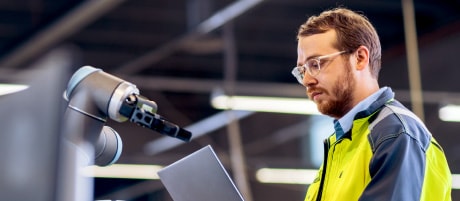

Advanced robotics
Advanced robotics integrates artificial intelligence into robots so they can perform intricate tasks and autonomously interact and respond to real-world complexities. Leveraging deep learning and neural networks, these robots can process vast amounts of data, adapt to dynamic environments and make real-time decisions. Enhanced sensor technology allows them to better perceive their surroundings. With the incorporation of human-robot collaboration principles, modern robots (or cobots) are designed to work seamlessly alongside humans.
The bottom line: Advanced robotics is transforming complex, labor-intensive physical processes, enhancing productivity, workforce safety, reliability and data-driven decision-making.
The technology in action
- Manufacturing efficiencies: Vision-guided robots have improved quality control by inspecting products, identifying defects and confirming consistent quality in mass production processes. Cobots operate alongside human manufacturing workers to enhance productivity and workforce safety by assisting in heavy lifting and intricate tasks.
- Labor support: In many sectors that face staff shortages, robots can help fill the gap. In healthcare, for example, advanced robotics can reduce nurse workload by taking on non-patient facing tasks such as automating the dispensing process at pharmacies.
- Assistance to specialists: Advanced robotics, when led by highly trained people, can help those people grow their capacity and perform even more complex tasks. Robots can, for example, enable surgeons to perform more precise and less invasive operations.
What’s next
Advanced robotics are increasingly becoming more accessible. Thanks to AI, it’s now easier than ever for people to “talk” to robots. This easier communication should foster unprecedented human-robot collaboration. Robotics-as-a-service is also a growing trend, since it can reduce the size of initial investments and enable more cost-effective flexibility and scalability.

Where to start
- Pinpoint the value. Identify where robots can augment human efforts — and if you already have robotics at work, look for potential upgrades that take advantage of the technology’s recent advances.
- Collect the data. Integrate robots with the IoT, turning them into data collection assets rather than simple task-oriented machines.
- Monetize the insights. With the help of AI, analyze the data that robots collect to find ways to reduce operating costs, increase speed to market and offer other competitive advantages.


Essential to experiment


Quantum computing
Quantum computing is poised to revolutionize classical computing — and it has the potential to transform industries. This technology can conduct far more complex operations exponentially faster than classical computing, and it can enable applications (such as AI) to produce reliable results even with smaller data sets. Quantum computing derives its immense power by using the principles of quantum mechanics to process information. Recent advances in quantum computing’s building blocks (quantum bits or “qubits”) are making the technology increasingly relevant to business. Its increasing reliability and fusion with classical computing (“hybrid quantum-classical”) paradigms could help computational power grow dramatically.
The bottom line: Quantum computing could soon enable computers and computer-based applications (such as AI, optimization, simulation) to perform far more complex operations and help solve previously “unsolvable” problems faster than conventional solutions.
The technology in action
- Asset management and antifraud: Quantum computing has the potential to revolutionize portfolio management and fraud detection.
- Pharmaceutical development and medical care: Quantum algorithms can help drive faster drug discovery, protein folding and more granular predictive models.
- Security: Defense companies can explore quantum computing for encryption, defense logistics and surveillance.
- Supply chains: Quantum algorithms can help manage increasingly complex supply chains and global inventories.
- Energy production: Quantum simulations can facilitate materials discovery, a more efficient power distribution grid and climate modeling.
What’s next
The next step for quantum computing is moving from the lab into the business world. Stability, processing capabilities and reliability are all increasing. Hybrid systems are helping to bridge the gap between current computing capabilities and next-generation quantum computing. For example, the “quantum internet” could offer ultra-secure communications, while quantum machine learning algorithms are starting to enable faster and more complex data processing.

Where to start
- Consider complex optimization challenges. The more impactful initial use cases are typically highly complex systems — such as supply chains — where you also have ample access to relevant data.
- Build alliances. With much cutting-edge quantum computing currently in academic settings, consider strategic collaboration with universities.
- Allocate resources and crowdsource. Assign specialists to keep up with developments and new opportunities. Given how exciting quantum computing is to many scientists, reach out too to your broader base of technologists to crowdsource ideas.


Neuromorphic computing
Neuromorphic computing mimics the architecture and functioning of the human brain. Unlike traditional computing systems that operate on the basic on-off principle of binary code, neuromorphic computing uses electronic circuits to emulate the brain’s intricate web of neurons, connections and interactions. A subset, neural interfaces, can facilitate a direct communication pathway between the brain and external devices such as prosthetics and other systems. Neuromorphic computing has vast implications for business, including faster AI decision-making with far less computing power and greater pattern recognition.
The bottom line: Neuromorphic computing could be the foundation for a new era in intelligent computing, creating efficiencies in both data processing and power consumption for better sustainability and greater cost savings.
The technology in action
- Autonomous vehicles: Neuromorphic computing can help AI make better real-time decisions by dynamically updating to accommodate new environments, helping to make autonomous vehicles safer and more reliable.
- Personalized health care: Healthcare professionals can use neuromorphic computing to adapt AI systems to individual patients. The result can be faster analysis of medical data, earlier and more reliable diagnoses and more effective, customized treatments.
- Robotics: Neuromorphic computing can help enable robots to more rapidly adapt to dynamic environments, optimizing performance and resource utilization across industries.
What’s next
Neuromorphic computing could soon enable AI to perform more complex tasks with less compute power, which could allow for faster advances in computing power and reduced energy consumption. Since the technology can often be integrated into mass-market devices, it may transform consumer products too. Still, before it can achieve success at scale, neuromorphic computing will need both hardware and software standards — both of which are currently often lacking.

Where to start
- Upskill key employees. Help build a foundation for neuromorphic computing through both internal training programs and outside educational opportunities.
- Connect with researchers. Consider relationships with academics and research institutions specialized in neuromorphic computing to help strengthen internal efforts and potentially discover promising enterprise applications early.
- Identify initial use cases. With the help of your upskilled employees and research allies, develop neuromorphic computing prototypes that can help address specific organizational needs.

Powerful convergence and transformation
Convergence among the Essential Eight is real — and accelerating. It is enhancing everyday processes and driving long-term transformation. The IoT blends with AI and blockchain for more resilient, transparent and agile supply chains. AI and quantum computing together can help improve travel routes for business travelers. Virtual and augmented reality blends with AI and the IoT to help develop products and services and enable seamless workforce collaboration across geographies. Neuromorphic computing and advanced robotics automate complex industrial processes.
These are just a few of many convergence examples in the business world today. Next comes more integration, helped by global standards and common approaches to enhance governance, sustainability and trust in data and transactions. GenAI’s potential ease of use and remarkable scalability can help make these technologies accessible.
The Essential Eight are powerful and when deployed responsibly, can give more people more opportunities to create value. Our future will be tech-powered but human-led. People will be in control, helping to grow trust and making data-backed high-risk and high-value decisions.
As they converge, this is the future that the Essential Eight can help build.
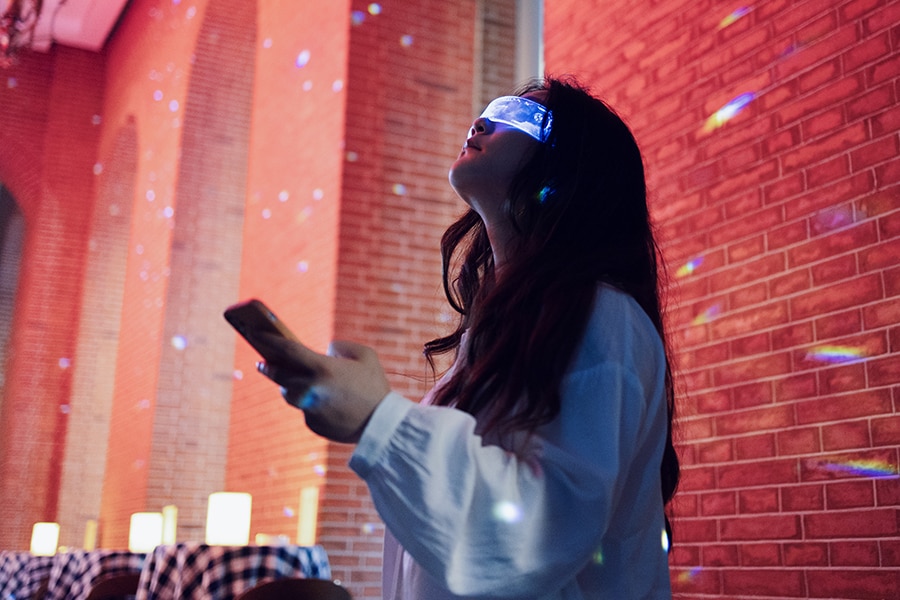
Are you ready to unlock the potential?
Discover new ways to transform your business with emerging technologies. Contact us to learn how we can help you put these technologies to work.








